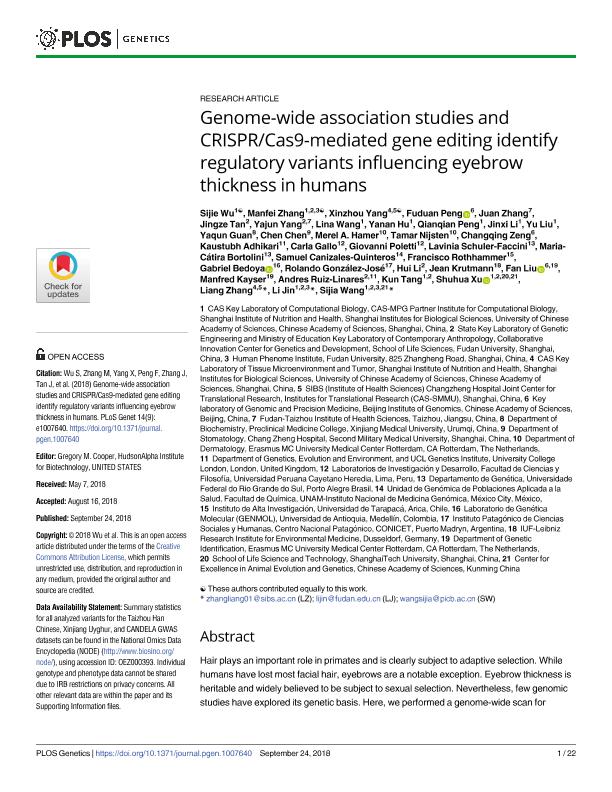Artículo
Genome-wide association studies and CRISPR/Cas9-mediated gene editing identify regulatory variants influencing eyebrow thickness in humans
Wu, Sijie; Zhang, Manfei; Yang, Xinzhou; Peng, Fuduan; Zhang, Juan; Tan, Jingze; Yang, Yajun; Wang, Lina; Hu, Yanan; Peng, Qianqian; Li, Jinxi; Liu, Yu; Guan, Yaqun; Chen, Chen; Hamer, Merel A.; Nijsten, Tamar; Zeng, Changqing; Adhikari, Kaustubh; Gallo, Carla; Poletti, Giovanni; Schuler-Faccini, Lavinia; Bortolini, María Cátira; Canizales Quinteros, Samuel; Rothhammer, Francisco; Bedoya Berrío, Gabriel; González José, Rolando ; Li, Hui; Krutmann, Jean; Liu, Fan; Kayser, Manfred; Ruiz-Linares, Andres; Tang, Kun; Xu, Shuhua; Zhang, Liang; Jin, Li; Wang, Sijia
; Li, Hui; Krutmann, Jean; Liu, Fan; Kayser, Manfred; Ruiz-Linares, Andres; Tang, Kun; Xu, Shuhua; Zhang, Liang; Jin, Li; Wang, Sijia
 ; Li, Hui; Krutmann, Jean; Liu, Fan; Kayser, Manfred; Ruiz-Linares, Andres; Tang, Kun; Xu, Shuhua; Zhang, Liang; Jin, Li; Wang, Sijia
; Li, Hui; Krutmann, Jean; Liu, Fan; Kayser, Manfred; Ruiz-Linares, Andres; Tang, Kun; Xu, Shuhua; Zhang, Liang; Jin, Li; Wang, Sijia
Fecha de publicación:
09/2018
Editorial:
Public Library of Science
Revista:
Plos Genetics
ISSN:
1553-7390
Idioma:
Inglés
Tipo de recurso:
Artículo publicado
Clasificación temática:
Resumen
Hair plays an important role in primates and is clearly subject to adaptive selection. While humans have lost most facial hair, eyebrows are a notable exception. Eyebrow thickness is heritable and widely believed to be subject to sexual selection. Nevertheless, few genomic studies have explored its genetic basis. Here, we performed a genome-wide scan for eyebrow thickness in 2961 Han Chinese. We identified two new loci of genome-wide significance, at 3q26.33 near SOX2 (rs1345417: P = 6.51×10−10) and at 5q13.2 near FOXD1 (rs12651896: P = 1.73×10−8). We further replicated our findings in the Uyghurs, a population from China characterized by East Asian-European admixture (N = 721), the CANDELA cohort from five Latin American countries (N = 2301), and the Rotterdam Study cohort of Dutch Europeans (N = 4411). A meta-analysis combining the full GWAS results from the three cohorts of full or partial Asian descent (Han Chinese, Uyghur and Latin Americans, N = 5983) highlighted a third signal of genome-wide significance at 2q12.3 (rs1866188: P = 5.81×10−11) near EDAR. We performed fine-mapping and prioritized four variants for further experimental verification. CRISPR/Cas9-mediated gene editing provided evidence that rs1345417 and rs12651896 affect the transcriptional activity of the nearby SOX2 and FOXD1 genes, which are both involved in hair development. Finally, suitable statistical analyses revealed that none of the associated variants showed clear signals of selection in any of the populations tested. Contrary to popular speculation, we found no evidence that eyebrow thickness is subject to strong selective pressure.
Palabras clave:
EYEBROW THICKNESS
,
ANCESTRY
,
CRISPR/Cas9
Archivos asociados
Licencia
Identificadores
Colecciones
Articulos(IPCSH)
Articulos de INSTITUTO PATAGONICO DE CIENCIAS SOCIALES Y HUMANAS
Articulos de INSTITUTO PATAGONICO DE CIENCIAS SOCIALES Y HUMANAS
Citación
Wu, Sijie; Zhang, Manfei; Yang, Xinzhou; Peng, Fuduan; Zhang, Juan; et al.; Genome-wide association studies and CRISPR/Cas9-mediated gene editing identify regulatory variants influencing eyebrow thickness in humans; Public Library of Science; Plos Genetics; 14; 9; 9-2018; 1-22; e1007640
Compartir
Altmétricas



